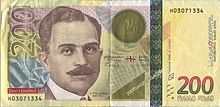Kakutsa Cholokashvili
Kaikhosro (Kakutsa) Cholokashvili | |
|---|---|
Leuville Cemetery (c. 1970) Mtatsminda Pantheon (2005) | |
| Allegiance | |
| Service/ | Cavalry |
| Years of service | 1909–1921 |
| Rank | Colonel |
| Battles/wars | World War I
|
| Awards | Gold Sword for Bravery (1916)[1] |
| Spouse(s) | Nino Meghvinetukhutsesi (1913) |
Kaikhosro "Kakutsa" Cholokashvili (
Born of a noble family, Cholokashvili was a decorated officer of the
Early life and career
Kakutsa Cholokashvili was born into an aristocratic family of
With the outbreak of
Independent Georgia
After the
When the
Partisan leader

As the Soviets pushed for the efforts to consolidate their power in Georgia, an underground opposition movement emerged. In February 1922, Cholokashvili was arrested by the Soviet security agents on charges of "counter-revolutionary activities" in
Foreign diplomats reported that "the affair of Chelokaev" was a source of much trouble for the Bolshevik military leaders.[7] The Soviet officialdom and historians referred to the movement as "political banditry". In his 1976 study of the Georgian revolt, the Soviet Russian historian Trifonov wrote that "the most numerous and dangerous band was that of Chelokaev. In the fall of 1922 it consisted of about 500 persons."[8]
In August 1924, Cholokashvili left his mountainous refuge once again to join a larger anti-Soviet uprising in Georgia. He took command of the single largest rebel unit operating in eastern Georgia.[9] Cholokashvili raided the town of Manglisi on 29 August, but, unable to get closer to Tiflis, he withdrew and attacked the Bolsheviks at Dusheti. Hunted down by the Soviet forces, Cholokashvili escaped on several occasions before conceding defeat. In September 1924, he fled across the porous border with Turkey. The Cholokashvili family—his wife and two little daughters—were rounded up and put in jail; his father-in-law was executed. Kakutsa's younger brother, Simon, had been killed earlier, during the revolt in Kakheti.[6]
Emigration

After leaving Georgia, Cholokashvili moved from Turkey to France, where many Georgian political émigrés had found refuge. He and his followers settled down at Viroflay, but received a cool welcome from the Leuville-sur-Orge-based Georgian government-in-exile, dominated by the Social-Democrats (Mensheviks). The Mensheviks treated Cholokashvili, a former nobleman, with suspicion, but were eager to exploit his standing among the Georgian nationalists for their political ends. On the other hand, Kakutsa (and many of his fellow military officers such as General Giorgi Kvinitadze) contemned the Mensheviks for their alleged disregard of national interests and indifference to the army.[5] Later in the 1920s, Cholokashvili was close to the right-wing nationalistic organization Tetri Giorgi.[6]
Making use of and contributing to further division among the Georgian émigrés, the Soviet intelligence leadership, especially,
Cholokashvili was first buried at the
Legacy



Under the Soviet rule, Cholokashvili's name was expurgated from the Georgian history for several decades. With the rise of nationalist and pro-independence movements in the 1980s, Kakutsa re-emerged as a major symbol of Georgian patriotism and resistance to the Soviet regime. In October 1990, his closest companion and comrade-in-arms, the 94-year-old émigré Aleksandre Sulkhanishvili, returned from his 66-year-long exile to a hero's welcome in Tbilisi, bringing Kakutsa's banner to Georgia. Sulkhanishvili died less than a month after his return and was buried in his native village.[12]
On 20–21 November 2005, Cholokashvili's remains were brought to Georgia and afforded a state funeral, in the presence of high-ranking government and church officials and thousands of Georgians, at the Mtatsminda Pantheon.[2] In 2007, Cholokashvili's portrait was depicted on Georgia's new 200-lari banknote.[13] The same year, Tbilisi's Marjanishvili Theatre staged Levan Tsuladze's successful production of "Kakutsa Cholokashvili", an epic patriotic play by Guram Qartvelishvili.[14]
References
- Federal Archival Agency. Retrieved 31 January 2015.
- ^ ISBN 978-1317815938.
- ^ "State Awards Issued by Georgian Presidents in 2003-2015".
- ^ a b c d Silakadze, Dimitri (2012). "უცნობი ფურცელი ქაიხოსრო (ქაქუცა) ჩოლოყაშვილის სამხედრო მოღვაწეობიდან [Unknown paper from the military activity of Kaikhosro (Kakutsa) Cholokashvili]". საქართველოს ისტორიის ინსტიტუტი: შრომები, № 5 [Proceedings of the Institute of History of Georgia, No. 5] (in Georgian and English). Tbilisi: Meridiani. pp. 293–306.
- ^ ISSN 1512-0449.
- ^ ISBN 978-1780230306.
- ^ Woodward, Ernest Llewellyn, ed. (1984). Documents on British Foreign Policy, 1919-1939. Her Majesty's Stationery Office. p. 148.
- .
- ISBN 978-0-253-20915-3.
- ^ "Kakoutsa Tcholokachvili (1888–1930)". Prométhée (in French). 4–6: 2–5. 1930.
- ^ "L'inauguration du tombeau de K. Tcholokachvili" [Inauguration of the tomb of K. Cholokashvili]. Prométhée (in French). 7–8: 31. 1932.
- ^ Tsamalashvili, Eka. "ნამდვილი გმირის სამშობლოში დაბრუნება – ალექსანდრე სულხანიშვილი [Return of a true hero – Aleksandre Sulkhanishvili]". დამოუკიდებლობის გაკვეთილები [Lessons of Independence] (in Georgian). Saakashvili Presidential Library. Archived from the original on 29 June 2016. Retrieved 1 May 2016.
- ^ "Georgia Issues Banknotes with Sokhumi Images". Civil Georgia. 1 April 2007. Retrieved 31 January 2015.
- ^ Eglinton, Andrew (3 January 2009). "Georgia Series: Kakutsa Cholokashvili". London Theatre Blog Archive. Archived from the original on 3 March 2016. Retrieved 31 January 2015.
